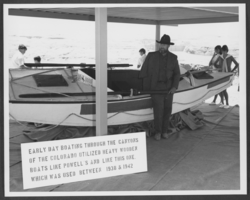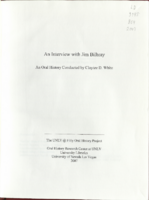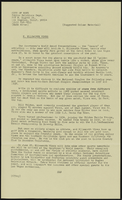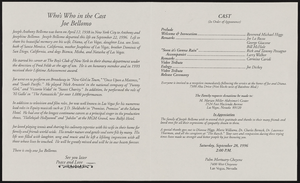Search the Special Collections and Archives Portal
Search Results
John E. Jeffrey oral history interview
Identifier
Abstract
Oral history interview with John E. Jeffrey conducted by Frank Vivirito on April 01, 1976 for the Ralph Roske Oral History Project on Early Las Vegas. Jeffrey discusses his occupational history, the disparity of work conditions and opportunities for Black and Mexican workers in the Henderson, Nevada magnesium plant, and his family’s medical history.
Archival Collection
Church, Robert, 1974 April 17
Level of Description
Archival Collection
Collection Name: Frank Mitrani Photographs
Box/Folder: Box 10
Archival Component

Photograph of Powell Commemorative Ceremony, Lake Powell, June 19, 1969
Date
Archival Collection
Description
Image

Transcript of interview with Jim Bilbray by Claytee D. White, September 6, 2006
Date
Archival Collection
Description
Text
Fairbanks, Celestia Adelaide “Ma” Johnson
wife of Ralph Jacobus Fairbanks and mother of Celesta A Lisle and Estella Frances Fairbanks Brown
Person
T-Shirt Color: Navy Blue; Front: Palm Springs Fire Department; Back: Palms Springs Fire Department, approximately 2001-2012
Level of Description
Archival Collection
Collection Name: New York-New York Hotel and Casino 9-11 Heroes Tribute Collection
Box/Folder: Box 179
Archival Component
Nancy Cummings-Schmidt oral history interview
Identifier
Abstract
Oral history interview with Nancy Cummings-Schmidt conducted by Stefani Evans and Claytee D. White on October 18, 2016 for the Building Las Vegas Oral History Project. In this interview, Cummings-Schmidt discusses her family background in Nevada dating back to the 1800s. She talks about her educational experiences in Las Vegas, Nevada and her work as a library aid at Nevada Southern University (now University of Nevada, Las Vegas). Later, Cummings-Schmidt discusses her role as the Young People’s Library Coordinator for the Sunrise Library in 1973 and talks about racism and sexism in children’s literature. Lastly, Cummings-Schmidt describes the technological development and changes in libraries.
Archival Collection



